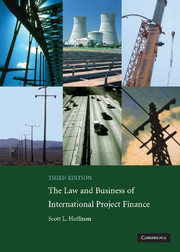 The Law and Business of International Project Finance
The Law and Business of International Project Finance from PART TWO - RISK IDENTIFICATION, ALLOCATION, AND MITIGATION
Published online by Cambridge University Press: 05 June 2012
RISK
What is risk? It has been defined as “uncertainty in regard to cost, loss, or damage.” Uncertainty is the important aspect of the definition. Project finance abhors it.
An important part of the successful closing of a project financing is the risk structuring process. It is during this process that risks are identified, analyzed, quantified, mitigated, and allocated so that no individual risk threatens the development, construction, or operation of the project in such a way that the project is unable to generate sufficient revenues to repay the project debt, pay operating expenses, and provide an attractive equity return to investors. This is done primarily through the contracting-out process – allocating risks among parties in contract form. In the following chapters, which make up Part 2 of this book, the risk structuring process will be examined.
Risks in a transnational project financing may be classified into two general categories: transnational and commercial. Subclassification is made for each risk in these two categories in the chapters dedicated to them. Beyond this classification system, risks can be examined at the participant level, identifying the risks most important to each.
By itself, risk identification is only a starting point. The processes of risk analysis and management are important next steps in structuring a successful project. The methods available to manage these risks (transfer to another participant by contract; mitigating the risk by sharing equity ownership with an entity that can reduce the risk; risk minimization and loss prevention; and credit enhancement), singularly or in combination, are discussed in the following chapters.
To save this book to your Kindle, first ensure no-reply@cambridge.org is added to your Approved Personal Document E-mail List under your Personal Document Settings on the Manage Your Content and Devices page of your Amazon account. Then enter the ‘name’ part of your Kindle email address below. Find out more about saving to your Kindle.
Note you can select to save to either the @free.kindle.com or @kindle.com variations. ‘@free.kindle.com’ emails are free but can only be saved to your device when it is connected to wi-fi. ‘@kindle.com’ emails can be delivered even when you are not connected to wi-fi, but note that service fees apply.
Find out more about the Kindle Personal Document Service.
To save content items to your account, please confirm that you agree to abide by our usage policies. If this is the first time you use this feature, you will be asked to authorise Cambridge Core to connect with your account. Find out more about saving content to Dropbox.
To save content items to your account, please confirm that you agree to abide by our usage policies. If this is the first time you use this feature, you will be asked to authorise Cambridge Core to connect with your account. Find out more about saving content to Google Drive.